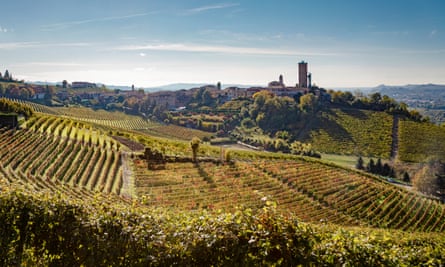
It’s brown, muddy-looking and could make your breath a bit stinky, but for lovers of the pungent and salty, bagna càuda is glorious. The recipe is simple: sliced garlic (a whole head per person!), olive oil and anchovies, cooked slowly to a sticky sludge into which diners dip potatoes, peppers (roasted or raw), celery, spring onions and, in Piedmont especially, cardoons – a thistle-like artichoke relative. With good friends, good bread and jugs of good red wine, it makes for a convivial evening.
It was wine that had drawn us to this part of north-west Italy: the Langhe area is famous for premium wines such as Barolo and Barbaresco. But I’d been intrigued also by a hilly area next door called Roero – Unesco-protected since 2014 – whose wines are starting to make their mark, and by the food specialities they compliment.
The Langhe landscape is wall-to-wall vines, but as soon as we cross the Tanaro River into Roero, the view is more varied, with stretches of ancient forest, orchards and hazel groves mixed with the vineyards. The rounded hills are also punctuated by dramatic rocche – ravines with cliffs, pinnacles and gullies, created when the Tanaro abruptly changed course 250,000 years ago. An outdoor centre in the village of Montà offers trail maps, mountain biking routes and more. (New to the e-bike market is motorbike maker MV Agusta, which has collaborated on four new e-bike routes around the wine villages.) But it’s pouring with rain and we have wine to taste.
King of Roero wines is Giovanni Negro, a larger-than-life figure who has built family business Angelo Negro into a maker of 21 classic and reserve labels. At his winery in Canale, he enthuses about the sandy soils of Roero, which make for fragrant, silky reds with raspberry and peach flavours preserved by ageing in large barrels, so the woody notes don’t dominate. They are also beautiful in the glass – a translucent crimson, like molten rubies.
But while the reds are famous, he is most proud of a white he developed from local grape arneis, to prove that it was possible to create a white wine that can be aged like a red. It took him 10 years, but today his 2019 Roero arneis Perdaudin is a rich, fruity, mouth-filling wine with a slight fizz and savoury tang from the mineral salts in the soil – and destined to go on getting better.
The best thing about Giovanni, though, is the way his enthusiasm has inspired Roero’s younger people. At nearby Vezza d’Alba’s truffle and wine fair next day, we’re surprised to see that while there are a few grizzled old boys, a good half of the winemakers picking up awards are barely out of their 20s.
This seems to be a hallmark of this bit of southern Piedmont – youngsters choosing to stay in rural areas for work, but bringing their own ideas. Of the several great restaurants we ate at in Langhe and Roero, Elena Risaglia’s Trattoria Belvedere, in the town of Serravalle Langhe, stood out for personality and simplicity.
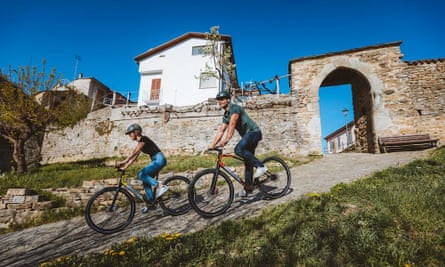
“I told her she’d have no social life, if she did this,” said Elena’s mother, Laura, but Elena, now 32, was set on taking over the restaurant kitchen from her parents. She put her own stamp on the menu (four courses from €27), partly by taking it back in time, reviving old piedmontese dishes such as tartrà, a savoury baked egg with herbs and fresh tomato sauce, and sweet and sour rabbit stew with a hint of chilli. Customers love this cucina povera (poverty cooking), said Laura, who now does front of house. But this is a rich land, Elena added, fertile valleys and hills teem with truffles, mushrooms and game, and poor people could make something wonderful from, say cabbage, onion and cheese.
Youngsters are getting ideas in the small Langhe town of Barbaresco too. At award-winning Casa Boffa, the founder’s twentysomething grandson is overseeing the addition of wine tourism to winemaking, with tours, tastings, and a characterful B&B with a breakfast terrace overlooking the Tanaro. A short walk away, the 30-metre Torre di Barbaresco was built in the late 1300s but fell into disrepair in the 20th century. Now restored, it’s a wine centre, with tastings, exhibition space and views from the top of these hallowed winelands – and snowy Alpine tops away to the west.
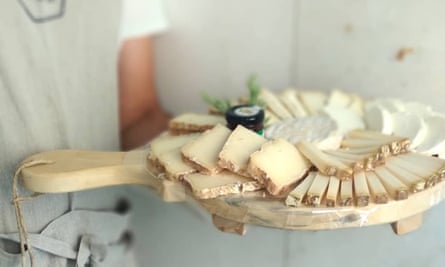
Since the turn of this century, wineries have been improving on these magnificent hills, commissioning site-specific artworks to complement them, especially from British/Swiss artist David Tremlett, known for wall paintings in museums, churches and town squares. Down a side street near Elena’s restaurant, Per le Langhe is a decommissioned chapel whose interior is a mix of 14th-century frescoes and Tremlett’s modern geometric designs in grey, black, green and white. Tremlett’s first work in Piedmont, made with late US artist Sol LeWitt, and commissioned by the Ceretti family in 1999, overlooks a vine-covered ridge in prime barolo country. The Cappella del Barolo, once a labourers’ chapel, now stands out from these hills in an eye-popping explosion of green, purple, orange, yellow, red and bright blue.
Another Tremlett-painted chapel, in an old monastery turned posh hotel, the Relais San Maurizio, can be visited for free by arrangement ([email protected]). The final stop on the Tremlett trail is another painted chapel in Coazzolo, with views over moscato vineyards as far as 3,841-metre Monte Viso on the French border.
Appetites sharpened by cutting-edge art, we returned to thinking about our stomachs, and what goes better with a full-bodied wine than tasty cheese? But that needn’t mean cows. At Cascina Raflazz, 770 metres up a southern Langhe hillside, the Adami family farm 300 pecora delle Langhe sheep, a breed they rescued from near-extinction. Tours take in the wide, breezy sheep fields, the workshop where raw milk becomes seven types of cheese, including origin-protected murazzano, and a guided tasting with cugna langhe, a fermented compote of pears, plums, grape juice, spices and nuts. A prized high-summer treat is day-old creamy little fresh sheep cheeses, made when grass is lush and days are long.
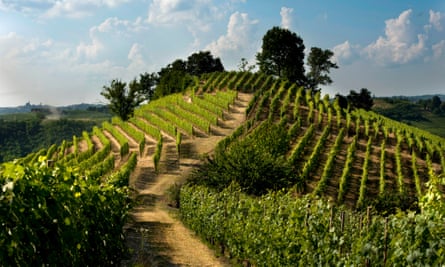
Even more specialised are young couple Barbara and Lorenzo at Borgo Affinatori, who don’t make cheese themselves but, since 2018, apply their expertise to making others’ produce delectable. They buy new cheese (which is just a brick of sour milk, Barbara points out) from selected small producers and add deliciousness with curing, spices and, the most important ingredient, time in their brick-lined cellar with rough-hewn wooden shelves. Rounds, squares, cylinders and big drums are tended like babies, turned over and washed, brushed, rubbed with oil, grappa, water and vinegar. In their tasting room a “clock” of cheeses included a sheepy-smelling salted ricotta, and a stracchino all’antica yellow from the beta carotene in fresh grass.
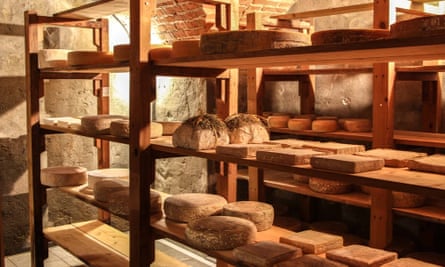
So that’s wine and cheese. All that’s missing is bread. In La Morra village, Mulino Sobrino is a 19th-century grain mill also benefiting from the slow food revival. In the 20th century the use of traditional millstones almost disappeared as millers switched to rollers. Owner Giovine Sobrino wisely bought up the stones as mills were demolished, and now the firm, organic since 1993, works with local farmers (for fewer grain miles) producing organic stoneground flour (lower glycaemic index, more nutrients) from wheat, oats, corn, rice and various ancient grains.
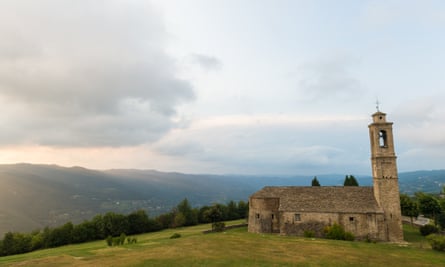
Giovine’s grandson, Stefano, gave us a tour of the only fully wooden mill in Italy: it looks like a working museum. Behind, in the miller’s house, are five spacious B&B rooms (from €95 B&B) and an apartment, all in pale colours with dark, wood-beamed ceilings. There’s a terrace and pool and, naturally, wonderful homemade bread and cakes for breakfast.
Other Piedmont food producers to visit
Cauda Miele, Montà
Claudio Cauda learned honey production from his father, who had been taught by a local priest. On free tours of hives and at a workshop, he tells the history of honey-making, evolving 21st-century tastes, worries about climate change, but also joy at how slow food drives people to seek out small producers. caudamiele.it
Abrigo Giovanni, Diano d’Alba
This family firm has 15 hectares (37 acres) of vines, but north- and east-facing hillsides are planted with 3,500 trees producing tonda gentile trilobata, said to be the world’s best hazelnut (they’re namechecked by Dante himself). Most are sold to Nutella or Ferrero Rocher, but fresh-picked in August they are particularly delicious. At other times, dried, salted hazels made a perfect nibble with their slightly sparkling favorita white, tasting of apples, pears and wild herbs. abrigo.it/en/
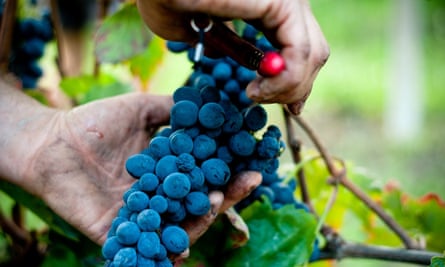
First’s Filet, Neviglie
Primo Montaldo (first of seven children, hence the name) is about 5ft tall with a handlebar moustache nearly as big, and has made his name producing another perfect wine nibble: cured pork fillets. These get a comprehensive treatment of soaking, salting and massages before relaxing for around 10 days in his curing rooms, then being rolled in herbs and spices or finished in wine, grappa or truffle. langhe-experience.it
Agriturismo Dindina, Neviglie
Helping run his parents-in-law’s agriturismo (doubles from €92 B&B), Gianluca offers Piedmontese cooking classes, making egg pasta tajarin (thin tagliatelle) by hand, plus local chocolate pudding bunet. dindina.it
Restaurants to try
Trattoria Belvedere Roero, San Grato, Monteu Roero
On a high hillside with views to the Alps, this favourite of local winemakers young and old also has an all-mushroom tasting menu (from €30).
Trattoria degli Amici, Castellinaldo
Specialising in fish, this village restaurant does great pasta with canocchie (crayfish) as well as local favourites ravioli del plin and tajarin. The vegan options are interesting too, and diners can watch chef Giovanni Muffini busy in the tiny kitchen via CCTV.
Il Vigneto, Roddi
Elegant B&B rooms with stunning views at this fine-dining restaurant cost from €90, but dinner in the restaurant is where your money will go: pastas for around €16, and mains from €18 cost a lot (€65) more if you choose a fresh truffle to grate over the dish. The wine list is so long it has its own contents page, and the truffle performance is worth witnessing: waiters gather solemnly round a Perspex box like neonatal intensive care consultants, selecting and weighing the precious nuggets, then bear one solemnly to a table under a domed lid.
Osteria dell’Arco, Alba
Dishes to try at this slow food Presidio member include excellent bagna cauda with roast peppers, and slow-cooked pork ribs with chickpeas and blue cheese gnocchi.
Where to stay
In the small town of Govone, with its Unesco-listed castle and popular Christmas market, B&B Ca’ Alfieri (doubles from £160 B&B) is an 18th-century house whose three elegant storeys are built into the side of the hill the town stands atop. This means great views from the large garden, which also has a pool. Bedrooms and breakfasts are generous, and the owners offer wine tastings with local products.



